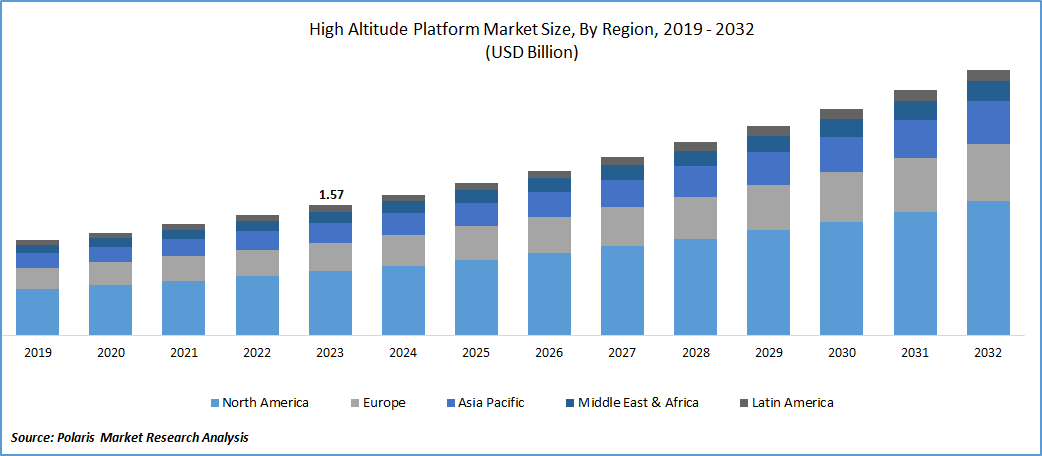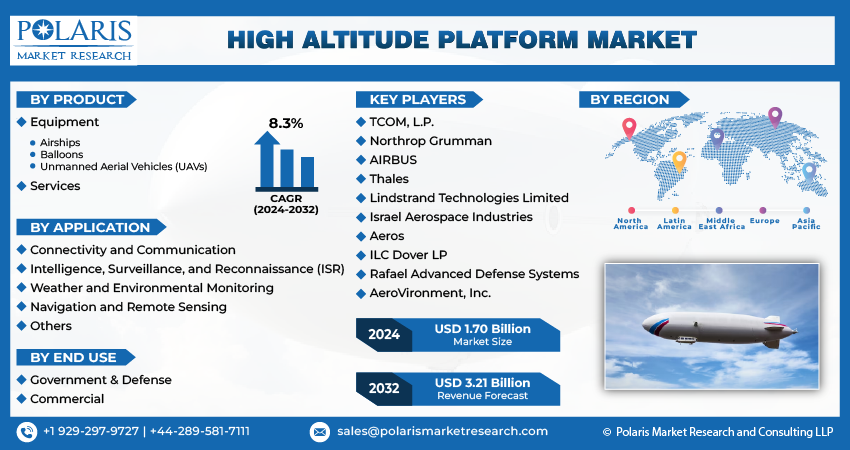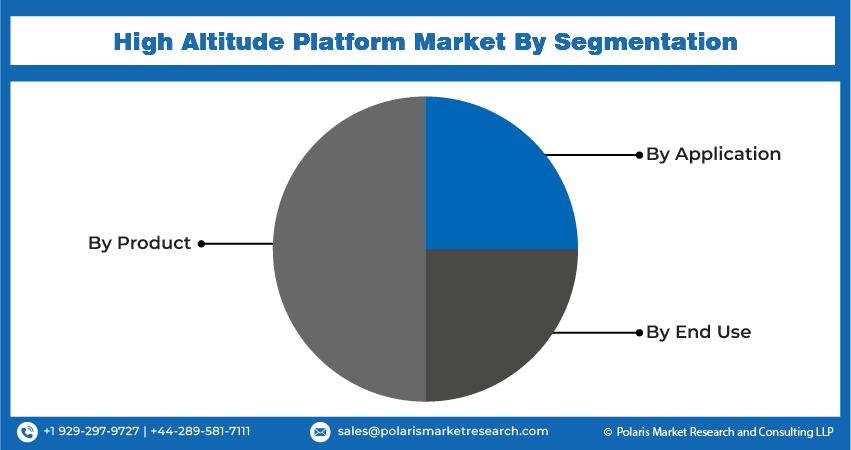
High Altitude Platforms Market Share, Size, Trends, Industry Analysis Report, By Product (Equipment, Services), By Application (Connectivity & Communication, Intelligence, Surveillance, & Reconnaissance), By End-use, By Region, And Segment Forecasts, 2024- 2032
- Published Date:Jan-2024
- Pages: 116
- Format: PDF
- Report ID: PM4206
- Base Year: 2023
- Historical Data: 2019-2022
Report Outlook
The global high altitude platform market was valued at USD 1.57 billion in 2023 and is expected to grow at a CAGR of 8.3% during the forecast period.
The research study provides a comprehensive analysis of the industry, assessing the market on the basis of various segments and sub-segments. It sheds light on the competitive landscape and introduces high altitude platforms market key players from the perspective of market share, concentration ratio, etc. The study is a vital resource for understanding the growth drivers, opportunities, and challenges in the industry.
The market's expansion is notably influenced by advancements in solar power technology, which enhances the power capabilities of high-altitude platforms (HAPs). The integration of improved solar cells contributes to the endurance and overall capabilities of these platforms, facilitating sustained operations at elevated altitudes. The increasing demand for persistent surveillance and communication solutions is a key driver for the market, with HAPs presenting a cost-effective alternative to conventional satellite systems. Their ability to linger over restricted areas for extended periods for disaster response, border movements & environmental monitoring.

To Understand More About this Research: Request a Free Sample Report
It aims to play a crucial role in closing the digital divide by establishing connectivity in previously unreachable areas on land, in the air, and at sea. An essential trend in the HAPs market is the increasing integration of artificial intelligence (AI). The incorporation of AI algorithms enhances the autonomy of these platforms, empowering them for real-time decision-making in adaptive navigation, communication, and mission-specific tasks. This integration not only enhances operational efficiency but also addresses the growing need for rapid data analysis in diverse operational scenarios.
The trend towards agile & robust aerial platforms is in line with the rising demand in the various sectors, particularly in defense & surveillance. The trajectory of the market is significantly influenced by international collaborations and partnerships. Governments & organizations are joining forces to combine resources & expertise, expediting the development & deployment of such platforms. Collaborative initiatives play a crucial role in overcoming regulatory challenges, sharing technological advancements, and establishing standardized frameworks for HAPs operations. This collaborative approach promotes a global perspective on HAP development, making it adaptable for use in different regions.

Industry Dynamics
Growth Drivers
Technological Advancements
The advancement of artificial intelligence (AI) capabilities in HAPs marks a significant shift toward more self-sufficient platforms capable of adapting to the dynamic environments. This development makes these platforms more challenging to predict or counter. The ongoing trend of miniaturization in components and payloads is also playing a crucial role in driving market growth. Technological advancements are leading to the reduction in size & weight of the sensors, communication equipment, & essential components. This not only increases payload capacity but will also enhance the agility & maneuverability of HAPs. Smaller & lighter platforms present challenges for traditional detection methods, adding a layer of stealthiness to their operations.
Report Segmentation
The market is primarily segmented based on product, application, end use, and region.
|
By Product |
By Application |
By End Use |
By Region |
|
|
|
|
To Understand the Scope of this Report: Speak to Analyst
By Product Analysis
Equipment segment accounted for the largest market share in 2023
Equipment segment accounted for the largest share. High altitude equipment, like airships, played a crucial role in this dominance by showcasing the capability to remain stationary at elevated altitudes for extended durations. This feature is pivotal for applications in telecommunications, surveillance, and environmental monitoring. Additionally, balloons emerged as versatile platforms, serving purposes such as scientific research, communication relay, and atmospheric studies.
The significance of HAP equipment lies in their ability to offer sustained coverage and data collection, creating possibilities for improved connectivity, surveillance, and scientific exploration across various applications. With ongoing technological advancements, airships and balloons are expected to play an increasingly integral role in shaping the industry.
Services segment will grow rapidly. Recent developments in HAP services represent a transformative era in aerospace capabilities. A noteworthy trend involves incorporating advanced AI algorithms. This not only enhances decision-making capabilities but also meets the need for rapid data analysis, rendering these platforms more resistant to detection by conventional AI detection systems. The progression of on-demand & customizable connectivity in the remote areas is gaining momentum, enabling users to customize connectivity services through HAPs according to specific mission requirements.
By Application Analysis
ISR segment held the significant market share in 2023
ISR segment held the significant market share. The utilization of ISR on the HAPs is experiencing transformative changes influenced by several prominent trends. The incorporation of advanced AI in ISR processes improves the platforms' capacity to autonomously analyze extensive data in real-time. This not only speeds up decision-making but also introduces an element of unpredictability, making detection by conventional AI systems more challenging.
Moreover, the inclination toward multi-sensor fusion is becoming increasingly notable, enabling HAPs to integrate data from various sources for a more thorough situational awareness. Additionally, there is a growing emphasis on adaptive ISR capabilities, empowering these platforms to dynamically respond to changing mission requirements. With the ongoing expansion of international collaboration in HAP technologies, the application of ISR on these platforms becomes more nuanced and versatile, presenting challenges for AI detection systems to predict or counter effectively.
Connectivity & communication segment is expected to gain substantial growth rate. Trends in the application of connectivity and communication on HAPs are reshaping the landscape of aerial networks. A key driver is the integration of advanced communication technologies, such as high-throughput data links and advanced signal processing, enabling seamless and robust connectivity services. The shift toward mesh networking and collaborative communication among HAPs enhances the reliability and coverage of aerial networks. As HAPs play an increasing role in bridging digital divides and offering connectivity in remote or disaster-affected areas, the deployment of cutting-edge communication technologies continues to advance.

Regional Insights
North America region dominated the global market in 2023
North America region dominated the global market. HAPs have become essential elements in numerous industries, playing a significant role in advancing telecommunications, surveillance, and scientific research. The expansive geography & diverse sectors in the region leverage the capabilities of the airships & balloons, ensuring persistent coverage for the communication networks, surveillance, & weather monitoring. The increasing demand for HAPs in the region is driven by their cost-effectiveness and adaptability, fostering innovation and technological development across various sectors.
The Asia Pacific will grow with substantial pace. HAPs are emerging as vital contributors to economic growth and technological innovation in this region. The diverse and expansive landscapes in the region pose unique challenges that HAPs adeptly tackle, catering to requirements such as remote communication, disaster response, and agricultural monitoring. The region's heightened emphasis on connectivity, coupled with rapid industrialization, positions airships and balloons as essential assets in addressing these challenges.
High Altitude Platforms Market (HAPs) are crucial in the expansion of telecommunication networks, enhancing disaster management efficiency, and aiding sustainable development initiatives in various countries across the region. With the increasing demand for advanced technology solutions, HAPs are set to play a central role in shaping the future of the market.

Key Market Players & Competitive Insights
Key players in the industry are actively pursuing competitive strategies, placing a strong emphasis on continuous product innovation, and forming strategic partnerships. The market is witnessing the emergence of agile and innovative startups that are introducing novel business connectivity services designed to meet the evolving requirements of the industry. This dynamic landscape reflects a commitment to staying ahead of the curve and adapting to the rapidly changing demands of the market.
Some of the major players operating in the global market include:
- TCOM, L.P.
- Northrop Grumman
- AIRBUS
- Thales
- Lindstrand Technologies Limited
- Israel Aerospace Industries
- Aeros
- ILC Dover LP
- Rafael Advanced Defense Systems
- AeroVironment, Inc.
Recent Developments
- In March 2023, The National Aerospace Laboratories (NAL) is set to deploy a High-Altitude Platform (HAP) designed for communication purposes. Initial testing has been conducted using a prototype capable of achieving a flight range of approximately 3 km.
High Altitude Platforms Market Report Scope
|
Report Attributes |
Details |
|
Market size value in 2024 |
USD 1.70 billion |
|
Revenue forecast in 2032 |
USD 3.21 billion |
|
CAGR |
8.3% from 2024 – 2032 |
|
Base year |
2023 |
|
Historical data |
2019 – 2022 |
|
Forecast period |
2024 – 2032 |
|
Quantitative units |
Revenue in USD million/billion and CAGR from 2024 to 2032 |
|
Segments covered |
By Product, Application, End use, By Region |
|
Regional scope |
North America, Europe, Asia Pacific, Latin America; Middle East & Africa |
|
Customization |
Report customization as per your requirements with respect to countries, region and segmentation. |
Explore the market dynamics of the 2024 High Altitude Platforms Market share, size, and revenue growth rate, meticulously examined in the insightful reports crafted by Polaris Market Rersearch Industry Reports. The analysis of High Altitude Platforms Market extends to a comprehensive market forecast up to 2032, coupled with a retrospective examination. Avail yourself of a complimentary PDF download to sample this in-depth industry analysis.
Browse Our Bestselling Reports:
Cumene Market Size, Share Research Report
Sensor Bearings Market Size, Share Research Report
Polyglycerates Market Size, Share Research Report
FAQ's
TCOM, L.P, Northrop Grumman, AIRBUS, Thales are the key companies in High Altitude Platforms Market.
The global high altitude platform market is expected to grow at a CAGR of 8.3% during the forecast period.
Product, application, end use, and region are the key segments covered.
Technological Advancements are the key driving factors in High Altitude Platforms Market.
The global high altitude platform market size is expected to reach USD 3.21 billion by 2032. .
